PEUGEOT 4008 2012 Owners Manual
Manufacturer: PEUGEOT, Model Year: 2012, Model line: 4008, Model: PEUGEOT 4008 2012Pages: 332, PDF Size: 9.17 MB
Page 131 of 332
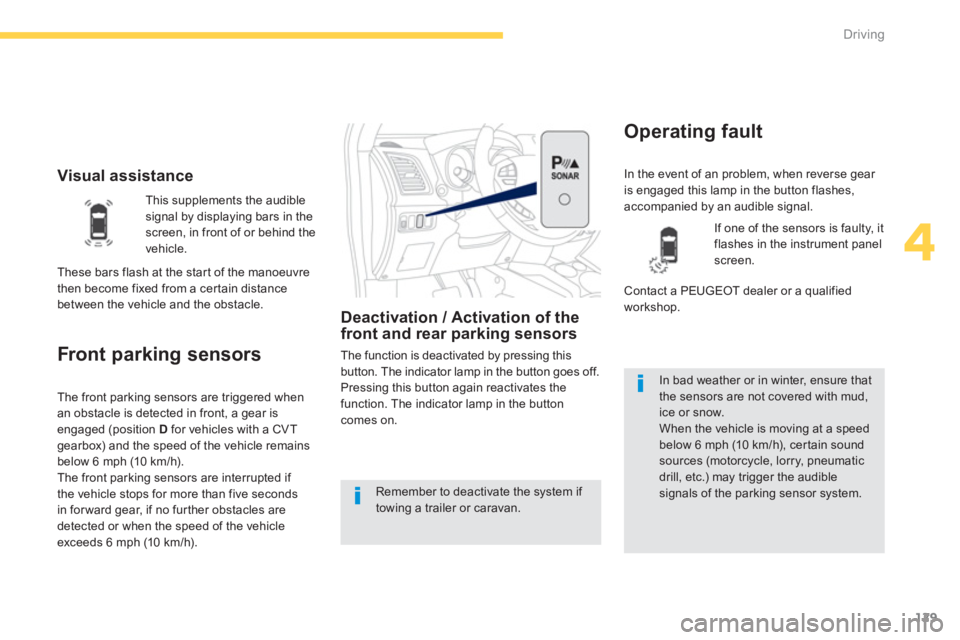
129
4
Driving
Visual assistance
Front par king sensors
Deactivation / Activation of thefront and rear parking sensors
The function is deactivated by pressing this
button. The indicator lamp in the button goes off.
Pressing this button again reactivates the
function. The indicator lamp in the button
comes on.
Operating fault
The front parking sensors are triggered when
an obstacle is detected in front, a gear isengaged (position Dfor vehicles with a CVT gearbox) and the speed of the vehicle remains
below 6 mph (10 km/h).
The front parking sensors are interrupted if
the vehicle stops for more than five seconds
in for ward
gear, if no fur ther obstacles are
detected or when the speed of the vehicle
exceeds 6 mph (10 km/h).
Remember to deactivate the system if towing a trailer or caravan.
In bad weather or in winter, ensure thatthe sensors are not covered with mud, ice or snow. When the vehicle is moving at a speed below 6 mph (10 km/h), cer tain soundsources (motorcycle, lorry, pneumatic drill, etc.) may trigger the audible signals of the parking sensor system.
In the event o
f an problem, when reverse gear
is engaged this lamp in the button flashes,
accompanied by an audible signal.This supplements the audiblesignal by displaying bars in the screen, in front of or behind the
vehicle.If one of the sensors is fault
y, it
flashes in the instrument panel
screen.
Contact a PEUGEOT dealer or a qualified
workshop. Th
ese bars flash at the start of the manoeuvrethen become fixed from a certain distance between the vehicle and the obstacle.
Page 132 of 332
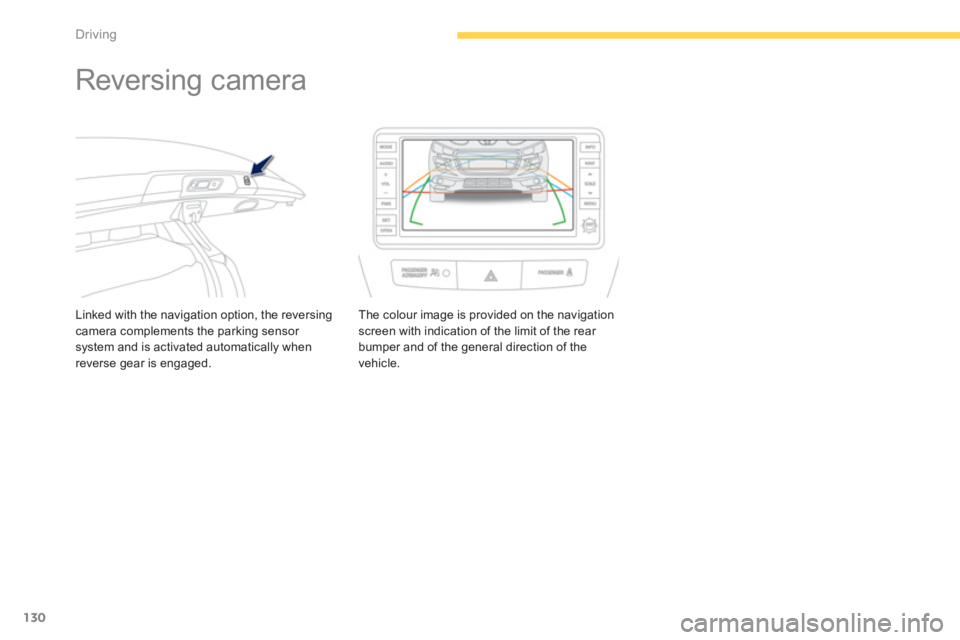
130
Driving
Reversing camera
Linked with the navigation option, the reversing camera complements the parking sensor system and is activated automatically whenreverse gear is engaged.The colour ima
ge is provided on the navigation screen with indication of the limit of the rear
bumper and of the general direction of the
vehicle.
Page 133 of 332
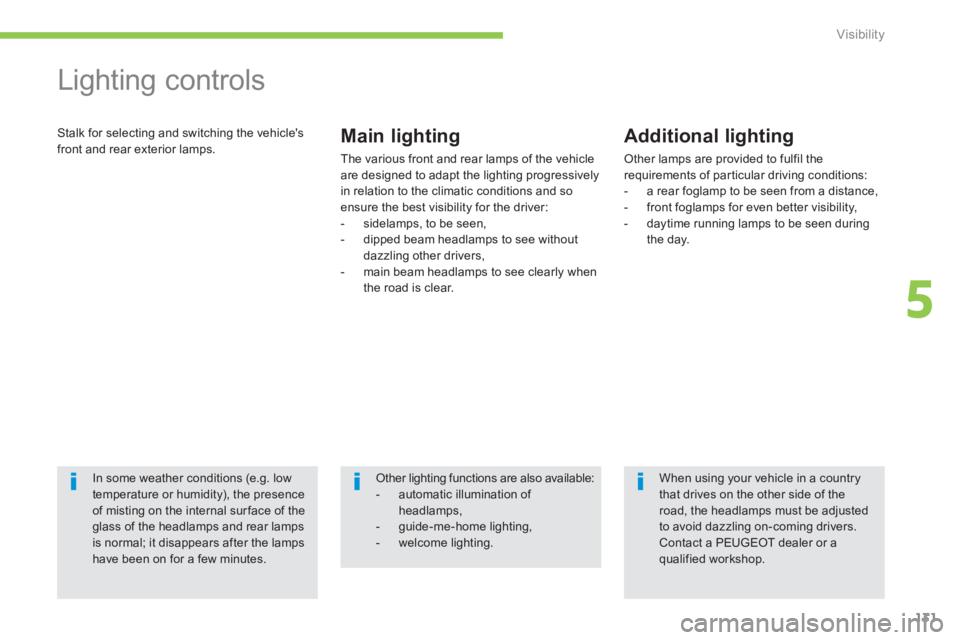
131
5
Visibility
Lighting controls
Stalk for selecting and switching the vehicle's
front and rear exterior lamps. Main lighting
The various front and rear lamps of the vehicle are designed to adapt the lighting progressively in relation to the climatic conditions and soensure the best visibility for the driver:
- sidelamps, to be seen,
-
dipped beam headlamps to see withoutdazzling other drivers,
- main beam headlamps to see clearly when
the road is clear.
Additional lighting
Other lamps are provided to fulfil the
requirements of par ticular driving conditions:
- a rear foglamp to be seen from a distance,
- front foglamps for even better visibility,
- daytime running lamps to be seen during
the day.
In some weather conditions (e.g. low temperature or humidity), the presence of misting on the internal sur face of theglass of the headlamps and rear lampsis normal; it disappears after the lamps have been on for a few minutes.
Other lighting functions are also available: - automatic illumination of headlamps,- guide-me-home lighting, - welcome lighting.
When using your vehicle in a countrythat drives on the other side of theroad, the headlamps must be adjusted to avoid dazzling on-coming drivers. Contact a PEUGEOT dealer or a qualified workshop.
Page 134 of 332
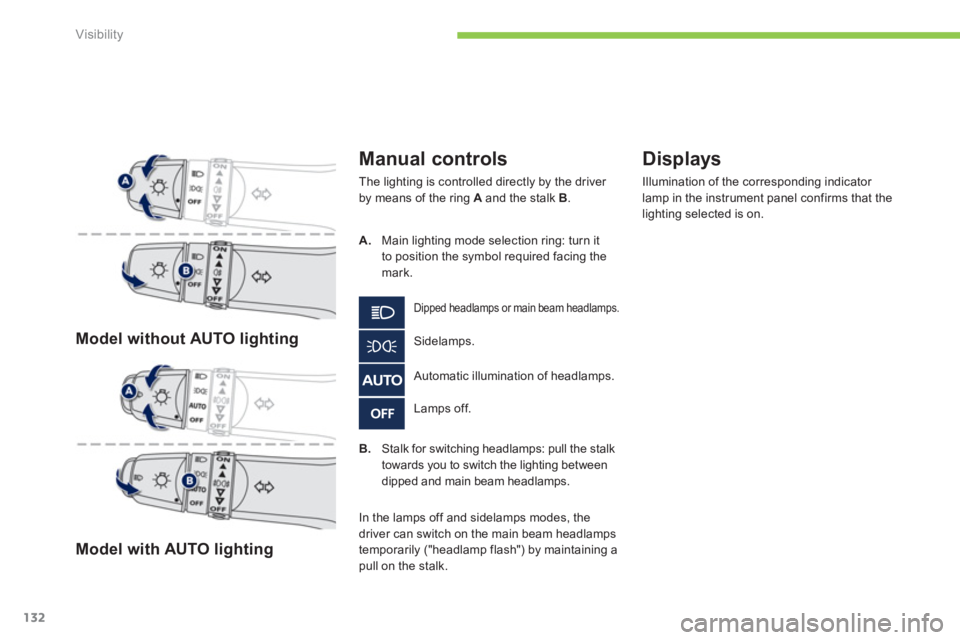
132
Visibility
Model without AUTO lighting
Model with AUTO lighting
Manual controls
The lighting is controlled directly by the driver by means of the ring A
and the stalk B
.
Lamps off.
Automatic illumination of headlamps.
Sidelamps.
Dipped headlamps or main beam headlamps.
Displays
Illumination of the corresponding indicator
lamp in the instrument panel confirms that the
lighting selected is on.
A. Main lighting mode selection ring: turn it
to position the symbol required facing the
mark.
B. Stalk for switching headlamps: pull the stalk
towards you to switch the lighting between dipped and main beam headlamps.
In the lamps o
ff and sidelamps modes, thedriver can switch on the main beam headlamps
temporarily ("headlamp flash") by maintaining a pull on the stalk.
Page 135 of 332
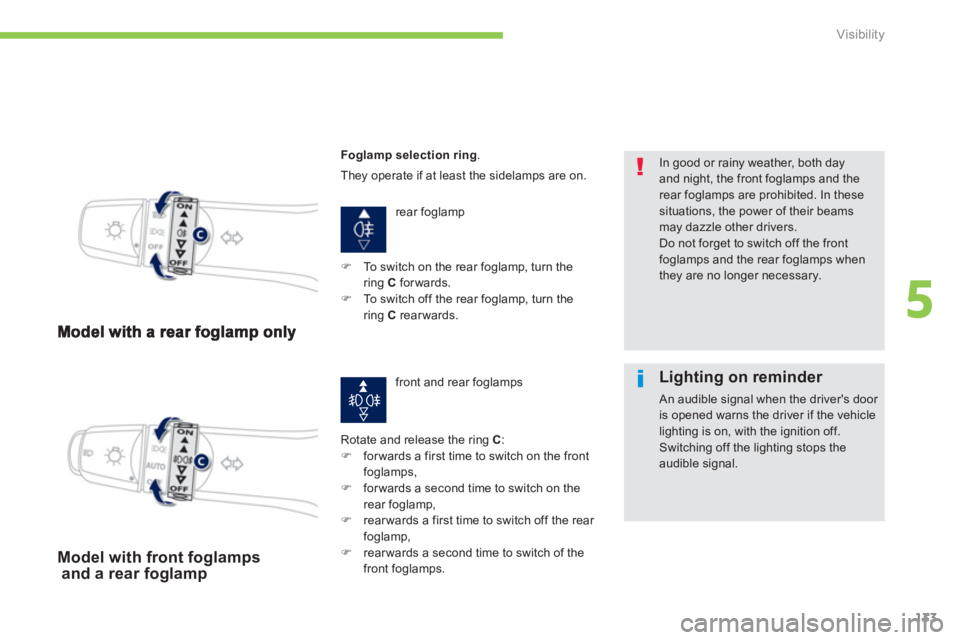
133
5
Visibility
rear foglamp
Rotate and release the rin
g C:�) forwards a first time to switch on the front foglamps,�)
forwards a second time to switch on the rear foglamp,�)
rearwards a first time to switch off the rear foglamp,�)
rearwards a second time to switch of thefront foglamps.
In good or rainy weather, both dayand night, the front foglamps and the rear foglamps are prohibited. In these situations, the power of their beams
may dazzle other drivers.
Do not forget to switch off the front foglamps and the rear foglamps when they are no longer necessary.
Model with front foglamps and a rear foglamp
Foglamp selection ring
.
The
y operate if at least the sidelamps are on.
�) To switch on the rear foglamp, turn the ring C
forwards. �)
To switch off the rear foglamp, turn thering C
rearwards.
front and rear fo
glamps
Lighting on reminder
An audible signal when the driver's door is opened warns the driver if the vehiclelighting is on, with the ignition off.
Switching off the lighting stops theaudible signal.
Page 136 of 332
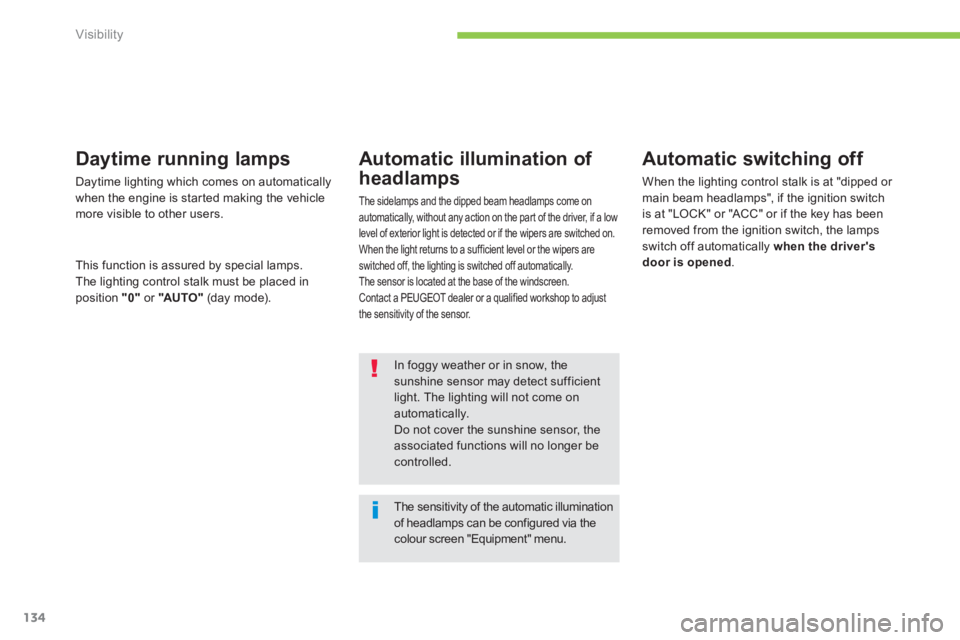
134
Visibility
The sensitivity of the automatic illumination of headlamps can be configured via the colour screen "Equipment" menu.
In foggy weather or in snow, thesunshine sensor may detect sufficient light. The lighting will not come on automatically. Do not cover the sunshine sensor, the
associated functions will no longer becontrolled.
Automatic switching off
When the lighting control stalk is at "dipped or main beam headlamps", if the ignition switch
is at "LOCK" or "ACC" or if the key has been
removed from the ignition switch, the lamps switch off automatically when the driver's
door is opened .
Daytime running lamps
Daytime lighting which comes on automatically
when the engine is star ted making the vehicle
more visible to other users.
This
function is assured by special lamps.
The lighting control stalk must be placed in
position "0"
or "AU TO "(day mode).
Automatic illumination of
headlam
ps
The sidelamps and the dipped beam headlamps come on
automatically, without any action on the par t of the driver, if a low level of exterior light is detected or if the wipers are switched on.
When the light returns to a sufficient level or the wipers areswitched off, the lighting is switched off automatically.
The sensor is located at the base of the windscreen.
Contact a PEUGEOT dealer or a qualified workshop to adjust
the sensitivity of the sensor.
Page 137 of 332
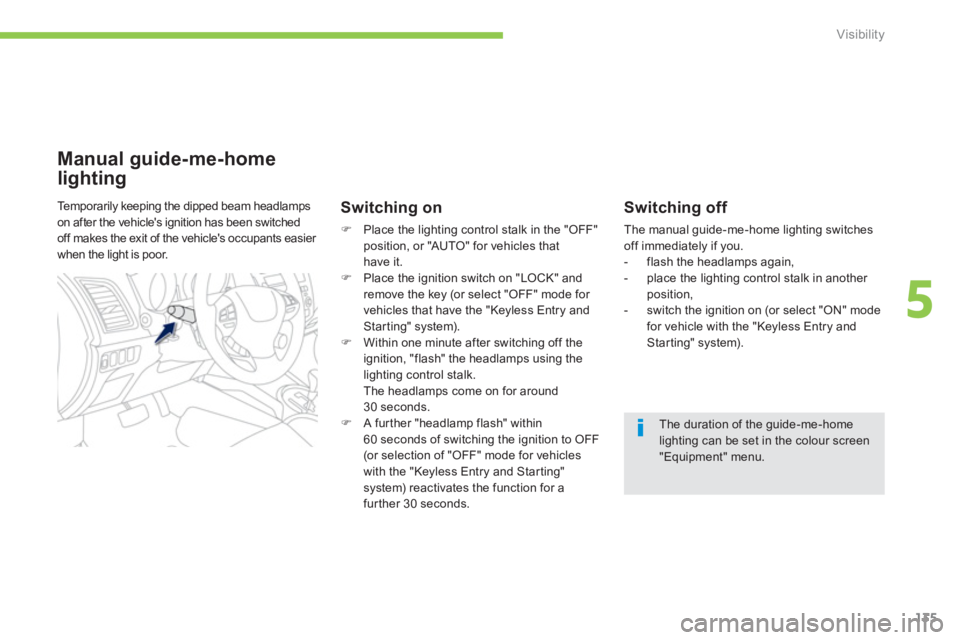
135
5
Visibility
Switching off
The manual guide-me-home lighting switchesoff immediately if you.
- flash the headlamps again,
- place the lighting control stalk in another
position,
- switch the ignition on (or select "ON" mode
for vehicle with the "Keyless Entry and Starting" system).
Manual guide-me-home
lighting
Switching on
�)
Place the lighting control stalk in the "OFF"
position, or "AUTO" for vehicles that have it. �) Place the ignition switch on "LOCK" and remove the key (or select "OFF" mode for
vehicles that have the "Keyless Entry andStarting" system). �) Within one minute after switching off the
ignition, "flash" the headlamps using the lighting control stalk.
The headlamps come on for around30 seconds. �) A further "headlamp flash" within 60 seconds of switching the ignition to OFF (or selection of "OFF" mode for vehicles
with the "Keyless Entry and Star ting" system) reactivates the function for a
further 30 seconds. Te m p o r a r i l
y keeping the dipped beam headlamps
on after the vehicle's ignition has been switched
o
ff makes the exit of the vehicle's occupants easier
when the light is poor.
The duration of the guide-me-home
lighting can be set in the colour screen"Equipment" menu.
Page 138 of 332

136
Visibility
Exterior welcome lighting Remote switching on of the lighting makes your approach to the vehicle easier in poor light.
It comes on when the vehicle is unlocked remotely.
Switching on
�) Place the lighting control in
position "OFF" or "AUTO".
�) Press the open padlock on the
remote contro
l or the electronic key.
The sidelamps come on for about 30 seconds. For vehicles fitted
with automatic illumination of
headlamps, the welcome lightingonly comes on under conditions of low ambient light.
Switching off
The welcome lighting goes off immediately if:
- you press the open padlock on the remote control,
- you place the lighting control in another position,
- you switch on the ignition (or select "ON"
mode for vehicles fitted with the "Keyless
Entry and Star ting" system).
It is possible to choose the type of lamps switched on or to deactivatethe function via the colour screen"Equipment" menu.
Page 139 of 332
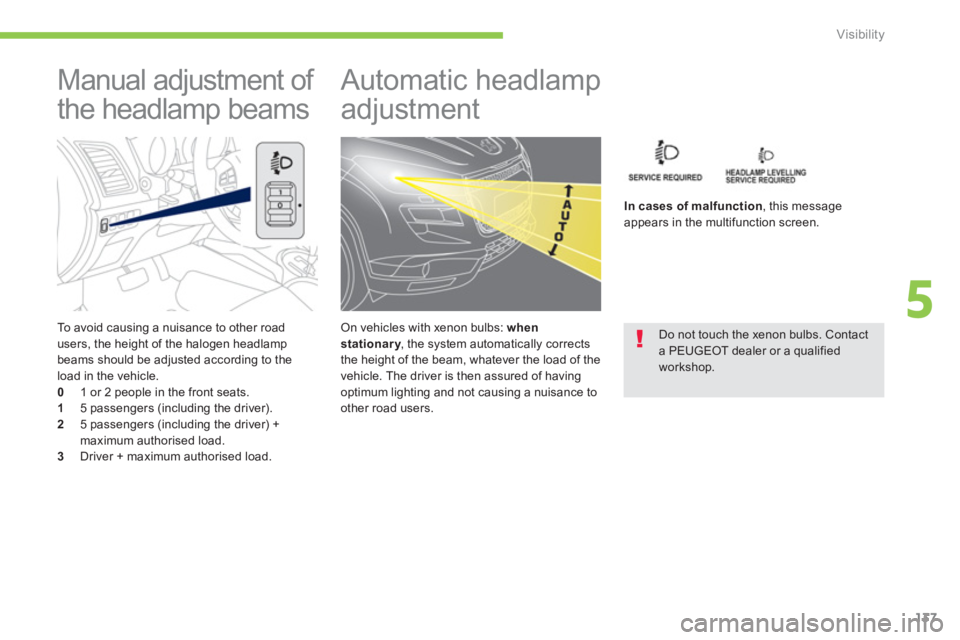
137
5
Visibility
To avoid causing a nuisance to other road
users, the height of the halogen headlamp
beams should be adjusted according to the load in the vehicle.0 1 or 2 people in the front seats. 1
5 passengers (including the driver). 2
5 passengers (including the driver) +
maximum authorised load.3
Driver + maximum authorised load.
Manual adjustment of
the headlamp beams Automatic headlamp
adjustment
In cases of malfunction, this message
appears in the multifunction screen.
Do not touch the xenon bulbs. Contacta PEUGEOT dealer or a qualifiedworkshop.
On vehicles with xenon bulbs: when stationary, the system automatically correctsythe height of the beam, whatever the load of the
vehicle. The driver is then assured of having
optimum lighting and not causing a nuisance to other road users.
Page 140 of 332
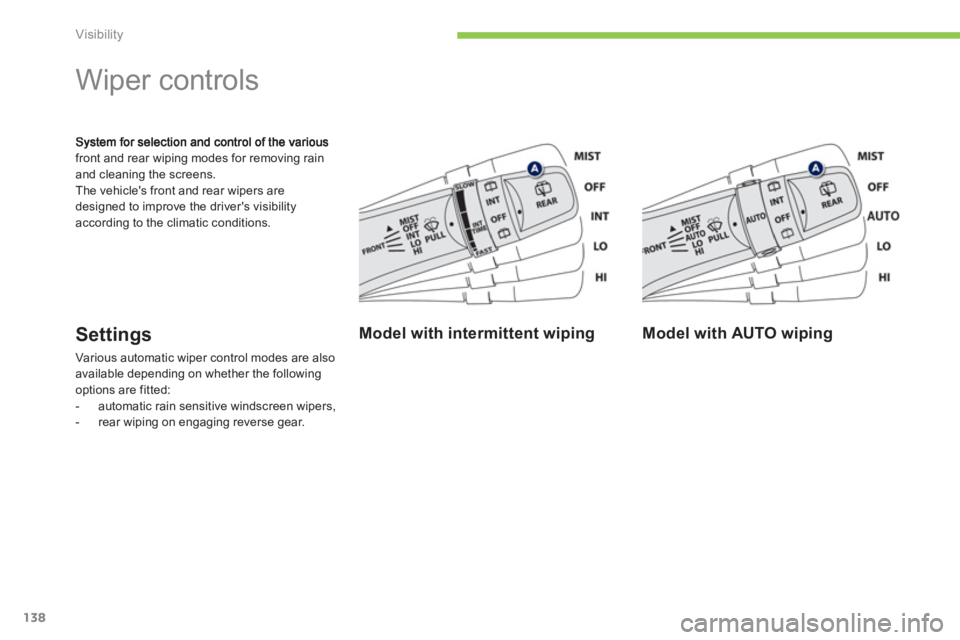
138
Visibility
front and rear wiping modes for removing rainand cleaning the screens.
The vehicle's front and rear wipers are
desi
gned to improve the driver's visibilityaccording to the climatic conditions.
Wiper controls
Settings
Various automatic wiper control modes are also available depending on whether the following
options are fitted:
- automatic rain sensitive windscreen wipers,
- rear wipin
g on engaging reverse gear.
Model with intermittent wiping
Model with AUTO wiping